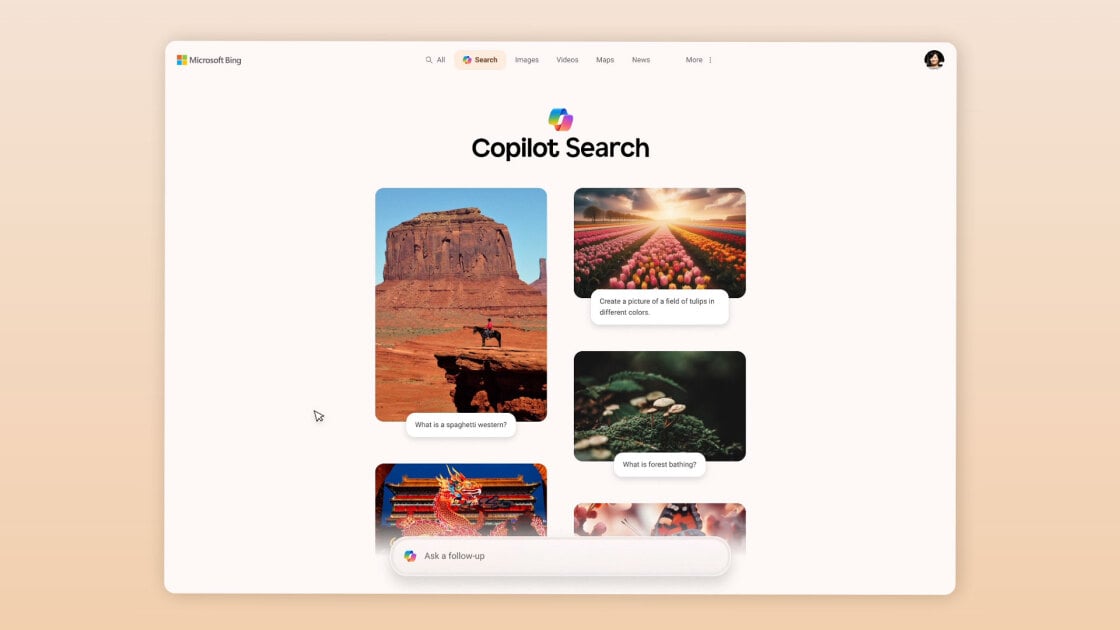Exploring Microsoft’s New AI Answer Tool: My Experience with Copilot Search

Microsoft’s Copilot Search feature in Bing distinguishes itself from other traditional search engines like Google, DuckDuckGo, and Bing’s own standard functionalities. Introduced during Microsoft’s 50th Anniversary Event in Redmond, Washington, Copilot Search presents users with clear source citations, the ability to refine search queries, and a transparent reasoning process behind its responses. Copilot Search aims to elevate the user experience by offering an enriched results page and numerous additional features.
This innovative search tool is available for both desktop and mobile users, and one of its advantages is that you do not need a Microsoft account to access it. During the anniversary event, I had the opportunity to test Copilot Search, and it has since been made available to over 90% of Bing users. I found it easy to access on both my laptop and smartphone.
1. Launch Bing
(Credit: Microsoft/PCMag)
To start using Copilot Search, head over to Bing.com. Input your search query as you normally would. Avoid selecting the Copilot button on the homepage; this will redirect you to the standard Copilot interface. For instance, I typed “rare bird sightings in Redmond, Washington” as my search.
2. Select Copilot Search

(Credit: Microsoft/PCMag)
Next, choose the second button from the left in the top row next to the “All” option. This selection will initiate an animation revealing related search queries generated by the AI based on your input, followed by the results page.
3. Review the Curated Results

(Credit: Microsoft/PCMag)
Although I was initially disappointed to find that there were no recent rare bird sightings in my area, I was pleasantly surprised by the additional features offered by Copilot Search, which significantly enhanced the experience.
4. Click “See Reasoning”

(Credit: Microsoft/PCMag)
This innovative feature provides insight into the AI’s understanding of your search intent. For my query, Copilot Search clarified, “The user is looking for information on recent sightings of rare birds in Redmond, Washington,” accurately capturing my needs.
5. Click “See All Links”

(Credit: Microsoft/PCMag)
This option is excellent for verifying Copilot Search’s sources and for deeper research. It offers a sidebar displaying the sources used for generating answers and all relevant links considered by the AI. The top section contains pages that contributed to its response, while the bottom section lists additional resources akin to standard web search results.
6. Examine Suggested Searches

(Credit: Microsoft/PCMag)
At the bottom of the results, suggested searches appear, providing a helpful way to refine your inquiry. In my case, the first suggestion was “Best birding spots near Redmond,” which was likely a more relevant query.
7. Pose a Follow-Up Question

(Credit: Microsoft/PCMag)
The search box featuring the Copilot logo allows you to enter any follow-up queries. What sets this apart from standard search engines is its ability to remember context, so you do not need to rephrase your entire inquiry. For example, I asked about “top species” or “rarest species,” and it automatically recognized the topic as bird species.
With its diverse range of capabilities, including insightful suggestions and context-aware follow-ups, Copilot Search offers compelling reasons to consider Bing, especially for users seeking an enhanced search experience. While Google provides AI Overviews in its results, it lacks the contextuality and depth found in Copilot Search.






